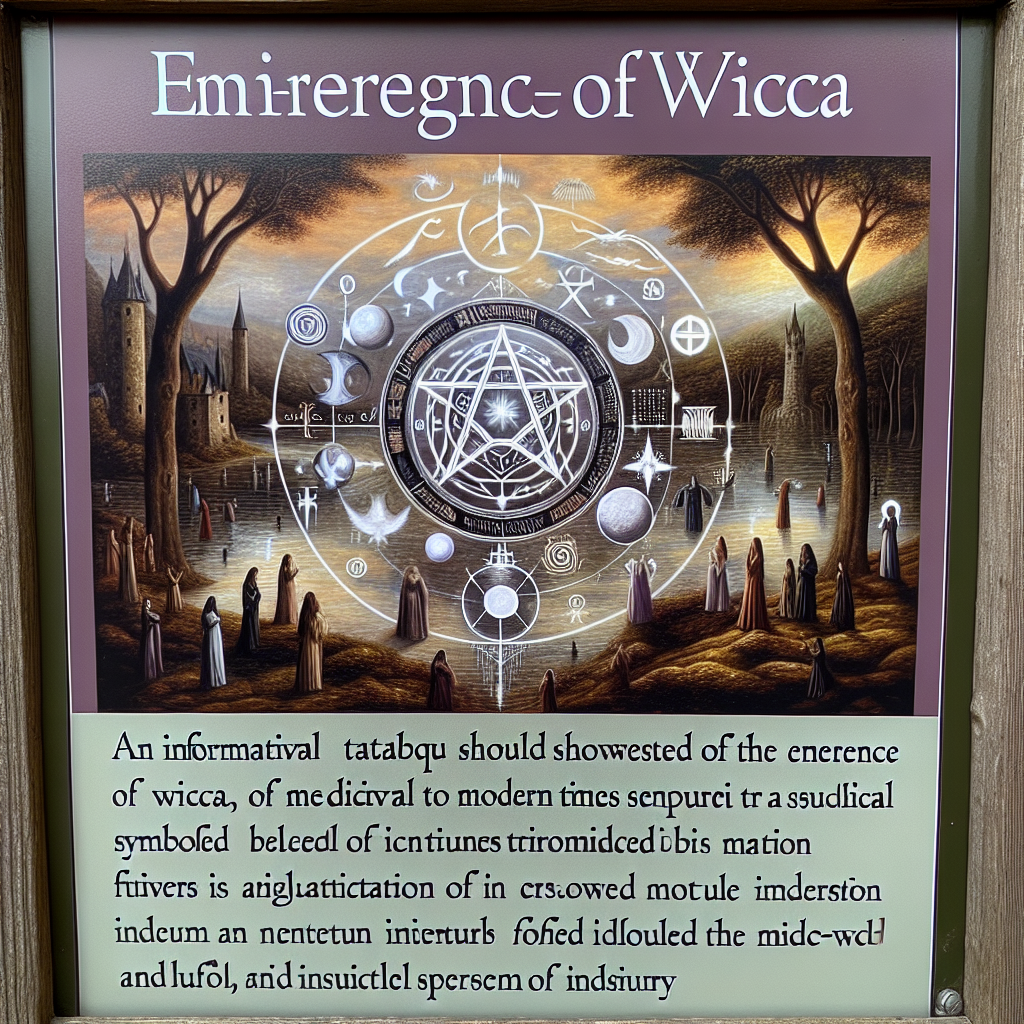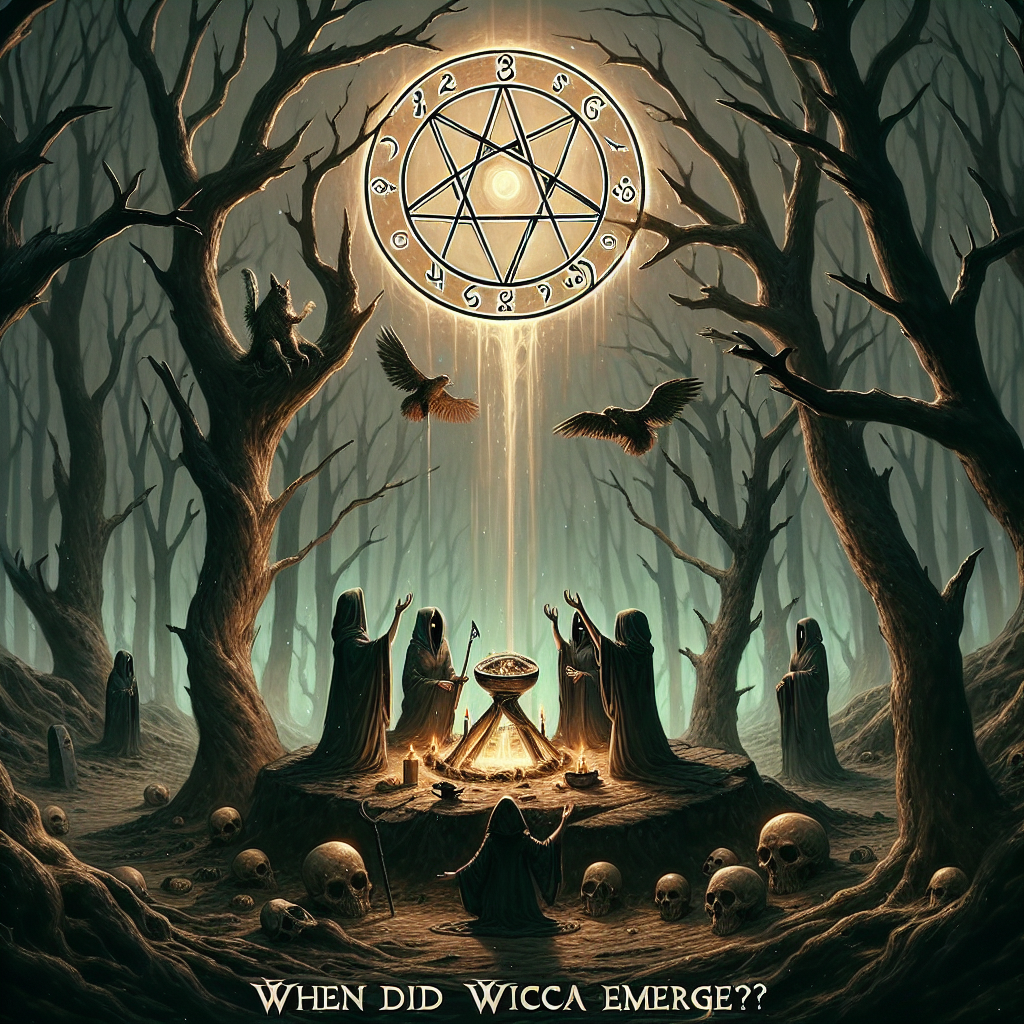As an Amazon Associate I earn from qualifying purchases.

Wicca, a modern form of witchcraft, is often wrapped in an aura of mystery and intrigue, with roots reaching back to pre-Christian traditions and customs. A fascinating blend of esoteric practices, nature worship, and ceremonial magic, Wicca is a decentralized religion that has captured the imaginations of people worldwide. Despite its ancient appearances, Wicca is a relatively new faith, having emerged in the mid-20th century as a distinct spiritual movement.
The origins of Wicca can be traced back to the 1940s and 1950s in the United Kingdom. Gerald Brosseau Gardner, often referred to as the ‘Father of Wicca,’ played a crucial role in bringing the religion into public consciousness. A retired British civil servant, Gardner spent several years in Asia, where he became acquainted with various rituals and magical practices. Upon his return to England, he claimed to have been initiated into a secret coven of witches in the New Forest region, which he said was a surviving remnant of an ancient, pre-Christian pagan religion. Gardner published several books on witchcraft, including “Witchcraft Today” (1954) and “The Meaning of Witchcraft” (1959), effectively sowing the seeds of the Wicca movement.
Gardner’s publications and advocacy sparked interest and debate among the public and scholars. By the 1960s, Wicca began to spread beyond the British Isles, capturing the attention of those in the United States and other parts of the world. As it grew, Wicca became not just a spiritual practice but also a symbol of counter-culture, resonating with individuals seeking an alternative to mainstream religious traditions. Statistics from various religious studies indicate that Wicca’s following, although difficult to quantify due to its eclectic and private nature, has been steadily growing, with particularly notable increases during the late 20th century.
The religion further evolved as it took root in different cultures, leading to a diverse array of traditions and practices within Wicca itself. Key figures, such as Doreen Valiente and Alex Sanders, emerged, each contributing their own philosophies and rituals to the practice of Wicca. Variations such as Gardnerian Wicca, Alexandrian Wicca, and Dianic Wicca highlight the adaptive nature of the faith, showing its ability to evolve and cater to the spiritual needs of its adherents. The Internet has played a significant role in the 21st century by facilitating the sharing of Wiccan practices, beliefs, and experiences, further enhancing the religion’s appeal to a global community seeking spiritual autonomy.
Wicca’s establishment as a legally recognized religion in various countries, complete with the right to perform legally recognized marriages and other rites, attests to its growth and acceptance into mainstream culture. Education about Wicca has led to a broader understanding and tolerance of the practice, alongside a greater appreciation for its emphasis on the environment, gender equality, and personal spiritual growth. The religion’s focus on the Wheel of the Year, celebrating seasonal festivals, and its reverence for the Earth has also found resonance in an era of rising environmental awareness.
“`html
What is the Origins and Developmental Timeline of Wicca?
“`
Wicca, often described as a modern pagan, witchcraft religion, has intriguing origins tracing back to the early 20th century. Its emergence is widely attributed to the works and influence of Gerald Gardner in the 1940s and 1950s, who is often hailed as the father of modern Wicca. Rooted in ancient, pre-Christian traditions, combined with ceremonial practices and Gardner’s own innovations, Wicca grew steadily as an organized and structured religion. It deftly incorporates ritualistic magic, reverence for nature, and worshipping of a goddess and sometimes a consort god, reflecting a duotheistic or sometimes polytheistic system. As we delve further into this mystical journey, let’s explore the detailed chronology of events and influential figures that shaped Wicca’s rich history, leading to its growth as a recognized spiritual path in the contemporary religious landscape.
Wicca, a modern pagan religion with a focus on the worship of nature and a duotheistic framework, emerged in the early to mid-20th century. Its inception is often credited to the British civil servant and amateur anthropologist Gerald Gardner, who is considered the father of modern Wicca. Here is a historical timeline outlining the key moments in the development of Wicca:
**Early 20th Century: Pre-Wiccan Developments**
– 1890-1930: Occultism and spiritualism gained popularity, setting the stage for Wicca. Groups such as the Hermetic Order of the Golden Dawn and individuals like Aleister Crowley contributed significantly to the esoteric milieu from which Wicca would draw.
– 1921: Margaret Murray published “The Witch-Cult in Western Europe,” which proposed the idea of a pre-Christian witch-cult, a notion that influenced later Wiccan beliefs.
**1930s-1940s: Gerald Gardner and the Formulation of Wicca**
– 1939: Gerald Gardner supposedly was initiated into the New Forest coven.
– 1949: Gardner published “High Magic’s Aid,” a novel that hinted at Wiccan practices, under the pseudonym Scire.
**1950s: Wicca Makes Its Public Debut**
– 1951: The Witchcraft Act of 1735 was repealed, making it safer for Gardner and others to practice and discuss their beliefs openly.
– 1954: Gerald Gardner published “Witchcraft Today,” revealing more about Wicca to the public and claiming the existence of an ancient witch-cult as outlined by Murray.
**1960s-1970s: Expansion and Diversification**
– The 1960s: Wicca spread to the United States and started to gain followers, diverging into various traditions.
– 1961: Raymond Buckland, a protégé of Gardner, brought Gardnerian Wicca to America.
– 1971: “The Complete Art of Witchcraft” by Sybil Leek further established Wicca in the public consciousness.
– 1979: Starhawk published “The Spiral Dance,” introducing the Reclaiming tradition of Wicca, which focused on feminism and political activism.
**1980s-1990s: Mainstream Recognition and Further Growth**
– Wicca began to be recognized as a legitimate religion, with the rise of Wiccan publications and public events.
– 1986: The District Court of Virginia ruled that Wicca was entitled to First Amendment Protection.
– 1990s: Increased visibility through the internet and popular culture, including films and television series, contributed to Wicca’s growing appeal.
**2000s-Present: Wicca in the Digital Age**
– Wicca continued to adapt and evolve with the proliferation of online platforms, forums, and social media.
– Eclectic practice increased, with practitioners often blending Wiccan elements with other spiritual beliefs.
– Modern Wicca has embraced environmentalism, equal rights, and inclusivity, reflecting contemporary societal values.
Statistical data on Wicca’s growth remains somewhat elusive due to its decentralized nature and the private practices of some adherents. However, the American Religious Identification Survey (ARIS) indicated that the number of self-identified Wiccans in the United States had increased from 8,000 in 1990 to 134,000 in 2001, demonstrating the significant growth of the movement in a relatively short time span. As of the latest estimates, which vary due to different counting methods, there are potentially hundreds of thousands of Wiccans worldwide, emphasizing its establishment as a global religious movement.
Q1: What is Wicca and when did it first emerge?
A: Wicca is a modern Pagan religion that draws from various pre-Christian, folkloric, and occult traditions. It first emerged in the early 20th century, with its more recognizable form becoming public in the 1950s through the works of Gerald Gardner.
Q2: Who is considered the founder of modern Wicca?
A: Gerald Gardner is widely considered to be the “father” of modern Wicca. He played a crucial role in bringing the religion to public awareness in the 1950s.
Q3: What are some key dates in the development of Wicca?
A: Key dates include the late 1930s when Gerald Gardner claims to have been initiated into the New Forest coven, 1954 when Gardner published “Witchcraft Today,” and 1959 when he published “The Meaning of Witchcraft,” further expanding public knowledge of Wicca.
Q4: Did Wicca exist before Gerald Gardner?
A: There is debate about this, but it is generally believed that while many of the elements that comprise Wicca, such as witchcraft and nature veneration, have ancient origins, Wicca as a structured, identifiable religious movement did not exist before Gerald Gardner’s teachings in the mid-20th century.
Q5: Is Wicca the same as witchcraft?
A: Wicca and witchcraft are not the same, although they are often associated with each other. Wicca is a religious belief system that includes the practice of witchcraft, while witchcraft itself can be a standalone practice without religious connotations.
Q6: Are there different traditions within Wicca?
A: Yes, Wicca includes a variety of traditions such as Gardnerian, Alexandrian, Dianic, and many eclectic forms that have emerged, each with its own specific practices and beliefs.
Q7: Has Wicca evolved since its emergence?
A: Certainly, since its emergence, Wicca has evolved and branched into various traditions and practices. It is also influenced by cultural changes and the individual beliefs of its practitioners.
Q8: What was the public’s initial reaction to Wicca?
A: The public’s initial reaction to Wicca was mixed, with intrigue from some and skepticism or fear from others, largely due to misconceptions associating it with historical witch hunts and negative stereotypes of witchcraft.
Q9: How has the perception of Wicca changed over time?
A: Over time, the perception of Wicca has become more positive, especially as information becomes more accessible and the religious movement gains more acceptance as a legitimate spiritual path.
Q10: Is Wicca recognized as an official religion?
A: Yes, Wicca is recognized as an official religion in many countries, and it has the same rights and protections as other religions under the law.
Conclusion
Wicca’s emergence can be largely attributed to the early 20th-century occult movements and the significant contribution of Gerald Gardner in the 1950s. Gardner is credited with founding what is now known as Gardnerian Wicca, after his initiation into a coven in the New Forest region in England and his subsequent publications. Throughout the mid-to-late 20th century, Wicca grew in popularity, branching into various traditions such as Alexandrian Wicca and Dianic Wicca, each with its unique rituals and beliefs. The religion found a welcome reception amidst the 1960s counterculture movements, with its reverence for nature and the divine feminine resonating with shifting societal values. As Wicca evolved, it became more public and spread internationally, with numerous books, gatherings, and organizations contributing to its growth and accessibility.
Wicca’s history is marked by its adaptability and the diversity of its followers who have shaped the practice according to their own interpretations and regional influences. From its secretive origins to its contemporary standing as a recognized religion, Wicca has demonstrated a remarkable capacity for change and development. Today, as a religion that celebrates ecological awareness, gender equality, and personal autonomy, Wicca continues to attract new practitioners globally. Its impact is evident in the rise of neopagan festivals, pop culture depictions, and the greater movement towards spirituality that intersects with environmentalism and social progressivism.
Amazon and the Amazon logo are trademarks of Amazon.com, Inc, or its affiliates.


